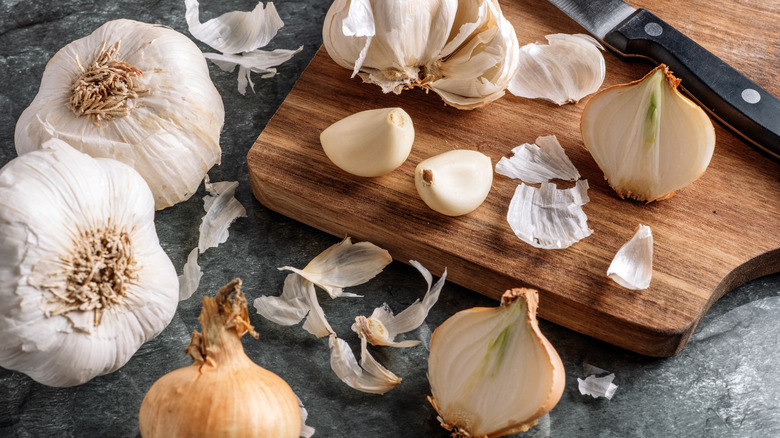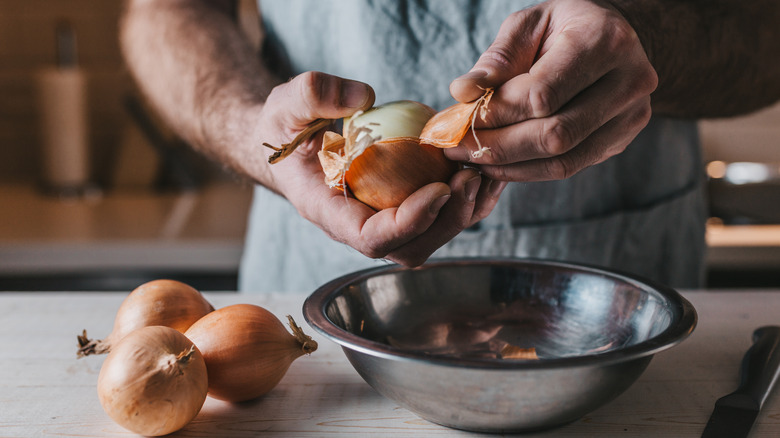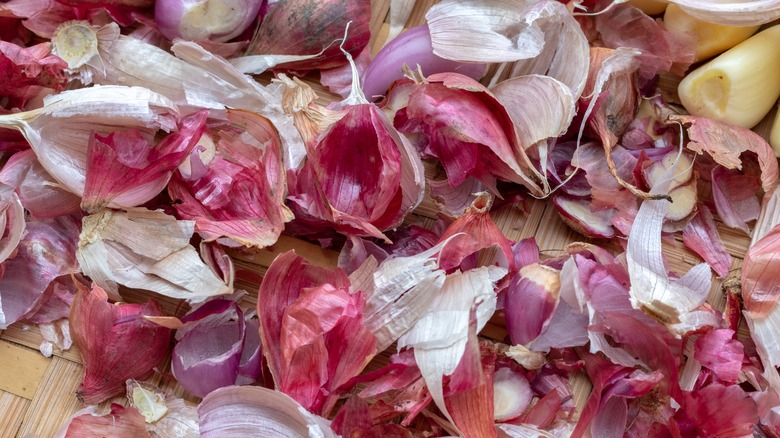How To Turn Garlic And Onion Peels Into A Zero-Waste Spice
Aiming for zero waste in our kitchens is not only a smart way to save money, but it's also a fun way to get creative with ingredients. When you consider how much gets thrown away from regular food prep, it's sometimes almost as much as the parts of food considered usable. For example, by the time you're done peeling carrots, potatoes, and beets, destemming broccoli, woody asparagus bottoms, and deseeding bell peppers, you've got a pile of produce to dispose of that is almost as big as the portions you're going to cook with. Although composting is a solution for kitchen waste, it's not always practical depending on your living situation. Instead of simply throwing vegetable peelings and cast-offs into the trash can, you can turn them into entirely new ingredients to cook with.
Garlic and onions are excellent for this purpose for a number of reasons. They are both readily available, relatively inexpensive, and are staples used extensively throughout many of the world's cuisines. Moreover, all parts of both plants are edible, including their peels, scapes, and skin. Because of their fibrous and papery textures, onion skins and garlic peels in their natural state could pose a choking risk and are mostly unpalatable, so eating them straight is not advised. However, only a minor amount of effort is needed to make them into a spice powder — you'll be surprised at just how easy it is to turn these scraps into a delicious and flavorful seasoning. Dry, grind, and go!
The free seasoning ingredients you're throwing in the trash
The next time you're peeling onions or chopping up garlic, don't throw away their skins. Instead, save them in a sealable bag kept in the freezer until there's enough to work with. Buy or grow organic to avoid synthetic pesticides and discard any moldy or extra dirty pieces before freezing. These aromatic allium peels have the same taste profiles as their more commonly used inner bulbs, and, once turned into a spice, are milder versions of garlic and onion powder that can be found at the grocery store. A viral video on TikTok by SpicyMoustache shows how to make zero-waste garlic powder, along with crispy garlic, and garlic oil for a true root-to-stem use of the entire vegetable. Onion peels can be used the same way, and you can combine garlic and onion skins together for an even greater depth of flavor.
@spicymoustache Me and @laja love garlic so much! It is such a versatile vegetable which takes a long time to grow and it would be a shame to waste any part of it as even the skin it's fully edible. GARLIC OIL AND CRISPY GARLIC 🧄 •1 cup x chopped garlic •2 cups x avocado oil or vegetable oil no olive oil STEP BY STEP 🥣 -in a pan heat the oil at fry temperature use a slice of garlic and put it in to see if the temperature is high enough to fry. -add the garlic and fry til golden -don't over fry it as it'll have a bitter burnt taste and will ruin the oil as well. -in a bowl drain the oil from the garlic . -store the oil in to a bottle -place the fried garlic on top of a muslin and let dry a bit from all the oil -store it in an airtight container up to one year . GARLIC SKIN POWDER: •onion peel •garlic peel •salt •pepper •paprika powder •chilly powder •optional flavours example: Mediterranean herbs, masala mix, chives & dill . STEP BY STEP: 🥣 – wash your peels together or separately depending on the quantity you have if you want 2 different powders. – tap them dry and place on a baking tray – bake at 160* for about 5 min keep an eye on it and make sure they nice and crispy when ready (turn off the oven and leave the door shut until dry). Alternatively, let the peel dry with the leftover heat inside your oven once you finish to cook (no energy use). – blend them until you have a fine powder. – add salt , pepper , paprika and chilly powder for a great fries potato seasoning or get creative using different mixed Mediterranean herbs or a masala mix . – the quantity depends on how much peels you have so taste the mix first to get the best result. #fyp #foryoupage #contentcreator #garlic #zerowaste #zerowastefood #homemadefood #zerowasteliving #easyrecipe #sustainability #healthyfood #recipe #asmrfood
Start by washing and drying your saved peels and skins. Lay them out on a rimmed baking sheet and bake for about five minutes at 320 degrees Fahrenheit. The idea is to get them dried and crispy, but not burnt, so keep an eye out and remove them from the heat before they start to turn dark. Once crisp, use a blender or mortar and pestle to crush them into a fine powder. Spicymoustache combines garlic and onion peels with salt, pepper, paprika, and chili powder for a powdered spice blend that's perfect for making seasoned fries.
Waste not, want not
The best thing about zero-waste spice made from peels is how versatile it is. You can use it in anything that could use a boost of piquant or umami flavor, including any recipes that call for fresh garlic, garlic or onion powder, granules, or flakes. Toss it in as a topping on hot buttered popcorn, roasted nuts, garlic bread, pizza, pasta, and steamed vegetables. Both garlic and onion flavors go well in spice rubs on meat or fish, sauces, marinades, salad dressings, soups, and egg dishes. You can even make a vegetarian broth by dissolving the spice powder in water. You can use the savory broth for cooking rice, quinoa, or other grains, or it can also be used to flavor soaking water, such as for beans, nuts, seeds, and dehydrated mushrooms.
It's a delectable addition to everything bagels and splendid when sprinkled on avocado toast. Another clever way to utilize garlic or onion skin spice is to bake it directly into bread. Knead it into your homemade dough to add a subtle toothsome touch to your next baguette or focaccia. You'll still get the taste of garlic or onion — or both — without the overpowering intensity of the whole vegetable bulbs. The sky is really the limit when it comes to the many ways to cook with this all-purpose seasoning, which is made even more enjoyable when you consider that you can make it at no extra cost from what was otherwise destined for the landfill.



